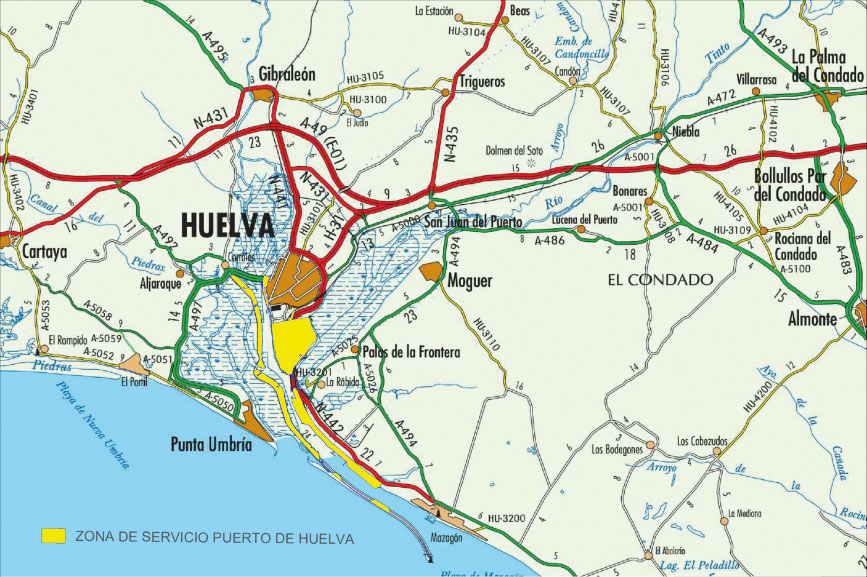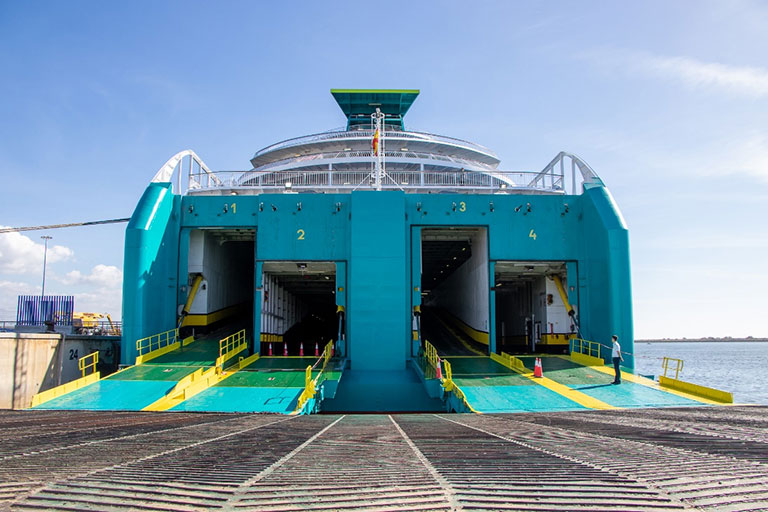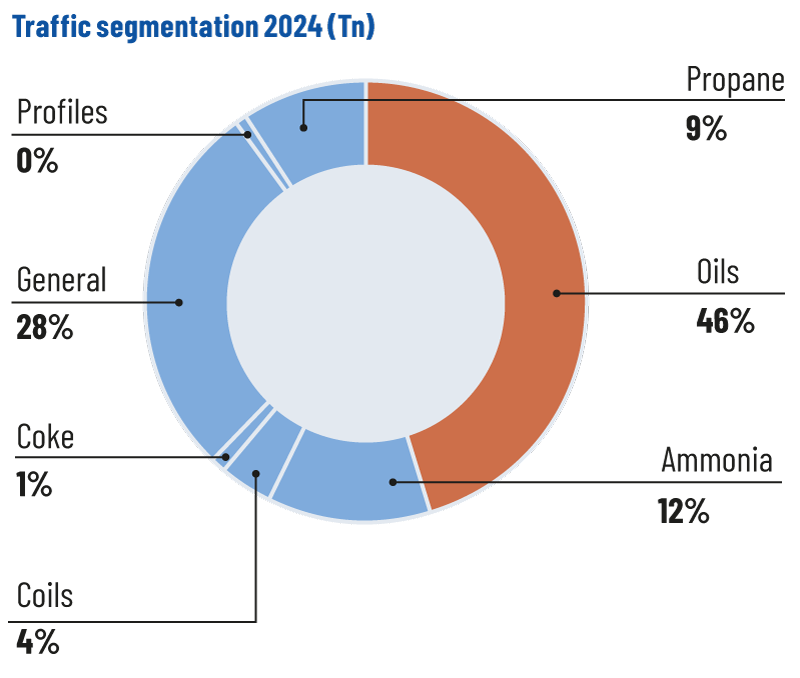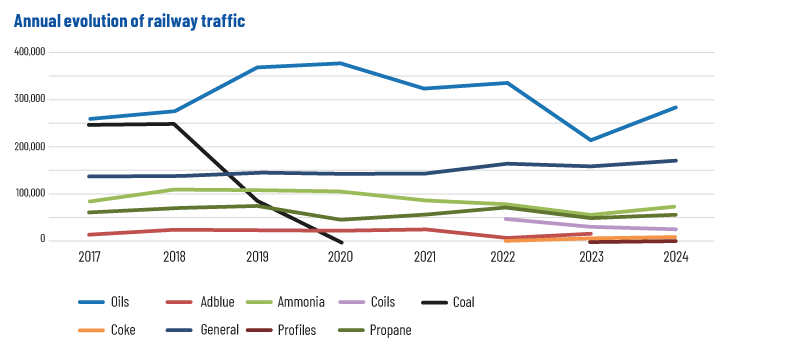Current and planned road and rail accesses and promotion of port-rail intermodality (I_22)
The main accesses to the Port of Huelva by road are from the A-49 motorway (Seville-Huelva-Portugal), via the N-441 (to the North), H-31 (to the East) and H-30 (Ronda Este de Huelva), which extends to the South with the N-442, from which the Outer Harbour is accessed. Also important for the Port of Huelva are the N-435 (from Badajoz and Zafra to Huelva) in the connection with Extremadura, which connects with the A-49 in San Juan del Puerto, the N-431 (Huelva-Portugal) and the regional roads A-494 (from San Juan del Puerto to Matalascañas via Mazagón), A-5000 (from Huelva to San Juan del Puerto), A-5025 (from A-494 to N-442 via La Rábida) and A-497 and A-492 which, via the bridges over the river Odiel, link the port area with Punta Umbría and other towns on the west coast of Huelva.
The most important measures planned for the Port of Huelva, in terms of external road network connections, are those which ensure a good level of service on the A-49 motorway, as well as on the N-435 towards Extremadura. Specifically, the continuation of the work to increase the capacity of the A-49 in the sections with the highest traffic intensity and the transformation of the N-435 (future A-83) into a dual carriageway, such as the Trigueros and Beas bypasses.
The condition of the internal roads in the Service Area provides an excellent level of service. The main artery is the route formed by the Avenida de Hispanoamérica, the Avenida Francisco Montenegro (Punta del Sebo road) and the Puente del Tinto, linking the inner docks and the Outer Harbour. Through the connection line with the general network, the Port of Huelva links up with the General Interest Railway Network managed by ADIF, with the Huelva Mercancías railway logistics terminal nearby, from which goods are dispatched, received and classified with the possibility of self-service management.
With regard to internal connections of the road network, actions are being carried out, such as the new link between the N-442 and the single access to the Outer Harbour (last mile action); and others of special interest are planned, such as the New Bridge over the River Tinto, connecting the A-494 at the Palos de la Frontera Bypass, with the H-30 (Huelva East Ring Road).
The national road 442 links the towns of Huelva and Mazagón and carries heavy traffic, with a high presence of heavy vehicles from the existing industrial estate where the La Rábida MOEVE Energy Park (formerly CEPSA) and the Enagás regasification plant are located, as well as the Outer Harbour of the Port of Huelva where Muelle Sur is located. This is used for general goods and containerised and Ro-Ro traffic, and is the place that might see the greatest expansion and future opportunities for the Port of Huelva. In the summer season, the traffic here is especially heavy, as it is the communication route between Huelva and the access to the beaches of Mazagón and surrounding areas.
For these reasons, it is necessary to widen the entire road, a measure that has been planned for more than a decade, in addition to reorganising all the accesses to the N-442, by means of service roads, eliminating some intersections or their replacement by junctions (at different levels) and an increase in capacity. All of this without forgetting the construction of the second bridge over the Tinto River to relieve the flow of traffic and ensure exit routes in the event of possible emergencies.
For the Port of Huelva, public investments aimed at improving rail and road connectivity with the centre of the Iberian Peninsula via Seville are strategic, as the V Centenary Motorway (A-49) is currently congested.

With regard to rail connections, the Port Authority of Huelva has had an agreement with ADIF since 2011. This agreement regulates the functions of the port’s rail infrastructure manager and establishes the way in which it connects with the General Interest Railway Network. All this in application of law 38/2015 of 29 September on the railway sector, which repeals law 39/2003.
With regard to the Improvement of Rail Accessibility, both in projects located within the Port Service Area and in relevant locations outside the Service Area, it is worth highlighting the commissioning in 2024 of the CMS (Control, Command and Signalling) subsystem interlinked with the CTC (Centralised Traffic Centre) of Santa Justa, allowing safe interactions by means of automatic blocking on double track, which is double-banked on the connection line, increasing the capacity of the Port’s railway infrastructure.
Several sections of track 2S2 have been renovated by renewing the current bedding layers: sub-ballast and ballast, as well as replacing the current wooden sleepers and the RN-45 type rail.
The Port Authority of Huelva and ADIF have signed an agreement which regulates the financial contributions of the APH from the Port Land Accessibility Financial Fund in relation to its contribution to the improvement actions on the Huelva-Seville Line. Specifically, 11 million euros have been earmarked for the construction of two 750-metre sidings on the Seville-Huelva line, which will allow 750-metre freight trains to operate, thereby optimising the rail corridor.
Therefore, the Port of Huelva has excellent land connectivity, especially by rail, with its hinterland. However, projects to improve the capacity of these infrastructures for the new rail transport standards require further development.
Internally, the I-RAIL project (Interoperability of the rail system with TAF TSI in TEN-T Corridors), enjoys the participation of the main players in the rail freight transport sector in Spain, Portugal and Italy, the support of the European Union Railway Agency and the Spanish Railway Safety Agency, and aims to improve interoperability in the exchange of information in European rail freight services through digitisation and the use of the TAF and TSI technical standards (defined in the Interoperability Directive 797/EC/2016), and to make rail freight transport more competitive, both in terms of costs and time. The technical and economic justification of the project was carried out in 2024. Final payment for the project is expected in the coming months.
Since 2020, the Port Authority of Huelva, the APH, has been developing, together with 17 European ports, another CEF project, called EALING (European flagship Action for Cold Ironing in ports). This aims to accelerate the development of infrastructures that allow ships docked in the Port to be supplied with electricity during their stay there, with the consequent benefits in energy and environmental efficiency. One of the main objectives of the project is to comply with Directive 2014/94/EU, which includes as a priority that the Core Ports of the Trans-European Transport Network, including the Port of Huelva, must have the necessary infrastructures for the supply of electricity to ships on land. These infrastructures should be available by 31 December 2030 for regular cargo lines, and represent a fundamental pillar in the fulfilment of the European strategy to convert ports into emission-free zones by 2030. In the specific case of the Port of Huelva, the aim of the project is to carry out all the studies and engineering work necessary for the future construction of the port infrastructures known as OPS (Onshore Power Supply) or Cold Ironing, so that when the current project is completed, the works can be put out to tender. The project also seeks to achieve technical and legal harmonisation at European level to standardise the processes for supplying electricity to ships. At the same time, it will reduce the energy costs of the ships operating in the Port of Huelva, improving their competitiveness. The technical and economic justification of the project was carried out in 2024. Final payment for the project is expected in the coming months.
With regard to the project “Improvement of the Railway Interoperability and Connections with the hinterland of the Port of Huelva”, the study of demand for the Railway Motorway service in the Port of Huelva, which began in 2022 was completed in 2023 and work is being carried out on the CBA. A master railway plan has been drawn up to analyse the entire railway operations of the Port of Huelva and to prioritise investments. The project, which has been underway since 2018, includes multiple preliminary actions (engineering, cost-benefit analysis, etc.) prior to the execution of the future diversification works at the Port of Huelva. One of these actions is the adaptation of the Muelle Sur rail terminal to allow the operation of the rail motorways. This activity will be a continuation of the analysis of the positioning and definition of a strategy for the Port of Huelva in relation to rail motorways, as well as taking into account the necessary adaptation of the rail network to the interoperability characteristics of the Trans-European and Transport Network Corridors (TEN-T network) (train length up to 750 m). It also envisages the design of a siding in the inner harbour area to support the terminal and allow trains of up to 750 metres in length to be parked and to eliminate potential bottlenecks in the inner harbour network. The project also includes the design of the railway safety and communications facilities, the adaptation of the land located in the multi-purpose area of the Muelle Sur zone as a support area for the terminal’s railway operations, a project for the renovation and adaptation of the internal railway network to comply with the European interoperability standards defined for the basic network. The project also includes a traffic reorganisation study (road and rail) in the area surrounding the Muelle Ingeniero Juan Gonzalo in order to promote rail transport in this area of the outer harbour, eliminating certain existing operational difficulties.
Since 2020, the Port Authority of Huelva has been developing, together with 17 European ports, another CEF project aimed to accelerate the development of infrastructures that allow ships docked in the Port to be supplied with electricity during their stay there.
This project is also financed with CEF and aims to improve railway interoperability and connections with the area of influence of the Port of Huelva, contributing to the objectives of decarbonisation of transport and compliance with the decarbonisation objectives set by the European Union. The project budget exceeds 961,000 euros, with a maximum co-financing percentage of 50% for this project.
The Intermodal Platform II Project of the Port of Huelva aims to transform the Port of Huelva into a sustainable and resilient port.
This is a study project consisting mainly of the improvement of the railway infrastructures of the Port of Huelva. The following works have been completed during 2024:
- CBA of the AAFF service and MEIPOR of the third track of the railway terminal.
- Work has begun on the railway master plan to analyse the entire railway operations of the Port of Huelva and to prioritise investments.
- MEIPOR of the container terminal extension.
- Analysis of alternatives for the construction of a siding in the service area.
- Study of the reorganisation of the Muelle Ingeniero Juan Gonzalo.
In 2022, the Port Authority of Huelva received approval from the Sustainable and Digital Transport Support Programme for the project called ROUTE TO AN INTERCONNECTED, DIGITAL AND FAST PORT. The objective of the project is the design, development, validation and implementation of a digital platform for the Port Community of the Port of Huelva. This consists of a system of federated platforms based on European standards of NGSI-v2 data exchange and its implementation through the FIWARE ecosystem. It is aimed at providing solutions for the digitalisation of processes and infrastructures and providing solutions to the needs of the port environment and the logistics chain and associated services inherent to the port through contextualised information sharing technology between the different agents of the network. The project was awarded with a budget of €1,267,925 and 40% funding. Work on the project continued in 2024. The work carried out during 2024 was as follows:
- First pilot of the container number plate reading system.
- Continuation of work on the digital platform and smart services for third parties.
- Continuation of work on the implementation of sensorisation and data collection infrastructure.
The last project also financed by CEF, for which work took place in 2024, was the Intermodal Platform II Project of the Port of Huelva which aims to transform the Port of Huelva into a sustainable and resilient port. It involves the construction of a new Ro-Ro ramp at Muelle Sur and the implementation of the electric power supply at the Muelle de los Minerales for the tugboats. The development of these works will make it possible to eliminate existing bottlenecks in the port infrastructure and improve the management of the expected demand for road traffic. The new infrastructure will further boost the development of the Atlantic Corridor, which includes the Port of Huelva, as the official hub of the maritime connection with the Canary Islands. The project is co-financed by the CEF Programme (Connecting Europe Facility) and runs from 2022-2024 with a total investment of 22,396,950.93 Euros, the maximum co-financing that APH can receive being 6,719,085.28 Euros, of which it has received an initial payment of 3,59,542.64 Euros as pre-financing, which corresponds to 50% of the agreed grant. The works included in the project are:
- Construction of a new Ro-Ro ramp at Muelle Sur, expected to be completed in the first quarter of the year.
- Implementation of the electricity supply at the Muelle de los Minerales, which has already been completed.
Boost to traffic by roll-on/roll-off loading and unloading (I_23)
The first ro-ro ferry milestone was in 2011 with the commissioning of a Ro-Pax ferry from Naviera Armas with a regular weekly service between Huelva and the Canary Islands. This was made possible by the installation of a floating Ro-Ro ramp by the shipping company.
In 2016, together with the inauguration of the new inspection facilities at Muelle Sur to speed up veterinary and phytosanitary inspections of products of animal or plant origin entering the European Union via this infrastructure, this type of traffic was boosted once again.

In 2018, the Port Authority of Huelva acquired the Ro-Ro ramp that enabled the launch of a new line with the Canary Islands on the Balearia & FredOldsen line. In 2024, the number of weekly services with the Canary Islands varied between three and four per week. At the end of the year, only Balearia & Fred Olsen were operating with three weekly services.
It should also be noted that in 2024, work advanced on a second Ro-Ro ramp on the Muelle Sur, which is expected to be commissioned before the summer of 2025.
Developments in rail and road transport and road operations (I_24)
The following table shows the evolution over the last three years in the Port of Huelva of the percentage of goods entering and leaving the Port by rail, in relation to the traffic handled by road and rail. It also shows the evolution of the percentage of maritime goods entering and leaving the Port by rolling loading and unloading operations, in relation to the total of general maritime import-export goods. Due to its importance for the Port of Huelva, the evolution of pipeline transport is also shown.
In terms of rail traffic, the statistical summary for this mode of transport during the year 2024 was as follows:
| 2022 | 2023 | 2024 | |
|---|---|---|---|
| Tonnes moved | 32,145,663 | 30,085,963 | 31,110,070 |
| Railway | 397,519 | 348,705 | 621,388 * |
| Road | 6,344,527 | 6,646,559 | 6,706,731 |
| Rail + road | 6,742,046 | 6,995,264 | 7,328,119 |
| % Rail/rail + road | 5.89% | 4.98% | 8.48% |
| Pipe | 22,861,471 | 20,402,399 | 20,997,199 |
| General Merchandise | 1,296,694 | 1,459,115 | 1,742,738 |
| Roll-on/roll-off cargo (non-TARAS) | 586,783 | 651,446 | 539,294 |
| % Rolling/General M. | 45.25% | 44.65% | 30.94% |
*Traffic declared by railway undertakings.
| 2024 | |
| Goods | Tm |
| Oils | 284,734.17 |
| Ammonia | 73,212.25 |
| Coils | 25,512.96 |
| Coke | 9,556.5 |
| General | 171,913.34 |
| Profiles | 1,942.72 |
| Propane | 54,515.83 |
| Grand total | 621,387.77 |

It is worth highlighting the recovery of the transport of oil by rail in 2024 and the incorporation of a new rail connection for general goods, with origin in Fuenlabrada. This is due to begin in December 2024, driven by the RU. Traction Rail, which will increase general cargo traffic in this mode over the next few years if consolidated.

| Sum of TN | 2017 | 2018 | 2019 | 2020 | 2021 | 2022 | 2023 | 2024 |
|---|---|---|---|---|---|---|---|---|
| Oils | 260,940.97 | 277,520.01 | 371,579.98 | 380,303.16 | 326,355.06 | 338,350.96 | 215,875.89 | 284,734.17 |
| Adblue | 15,787.52 | 24,360.65 | 24,543.21 | 22,353.73 | 24,406.80 | 6,821.40 | 12,462.50 | - |
| Ammonia | 88,236.38 | 110,307.30 | 109,221.42 | 106,001.58 | 87,419.97 | 78,940.37 | 56,212.25 | 73,212.25 |
| Coils | 5,369.51 | - | - | - | - | 47,159.75 | 30,621.23 | 25,512.96 |
| Coal | 248,650.00 | 250,750.00 | 86,150.00 | - | - | - | - | - |
| Coke | - | - | - | - | - | 675.10 | 5,529.64 | 9,556.50 |
| General | 140,175.66 | 139,605.96 | 145,009.00 | 143,778.78 | 144,209.85 | 165,702.78 | 159,986.53 | 171,913.34 |
| Profiles | - | - | - | - | - | - | 1,075.63 | 1,942.72 |
| Propane | 59,908.05 | 68,608.94 | 75,343.25 | 45,902.97 | 56,164.01 | 72,455.85 | 49,341.49 | 54,515.83 |
| Overall total | 819,068.09 | 871,152.86 | 811,847.76 | 698,340.22 | 638,555.69 | 710,106.21 | 531,105.36 | 621,387.77 |